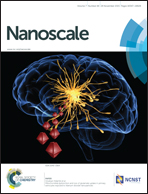Facilitated extracellular electron transfer of Shewanella loihica PV-4 by antimony-doped tin oxide nanoparticles as active microelectrodes†
Abstract
Dissimilatory metal reducing bacteria are capable of extracellular electron transfer (EET) to insoluble metal oxides as external electron acceptors for their anaerobic respiration, which is recognized as an important energy-conversion process in natural and engineered environments, such as in mineral cycling, bioremediation, and microbial fuel/electrolysis cells. However, the low EET efficiency remains one of the major bottlenecks for its practical application. We report firstly that the microbial current generated by Shewanella loihica PV-4 (S. loihica PV-4) could be greatly improved that is up to ca. 115 fold, by adding antimony-doped tin oxide (ATO) nanoparticles in the electrochemical reactor. The results demonstrate that the biocompatible, electrically conductive ATO nanoparticles acted as active microelectrodes could facilitate the formation of a cells/ATO composite biofilm and the reduction of the outer membrane c-type cytochromes (OM c-Cyts) that are beneficial for the electron transfer from cells to electrode. Meanwhile, a synergistic effect between the participation of OM c-Cyts and the accelerated EET mediated by cell-secreted flavins may play an important role for the enhanced current generation in the presence of ATO nanoparticles. Moreover, it is worth noting that the TCA cycle in S. loihica PV-4 cells is activated by adding ATO nanoparticles, even if the potential is poised at +0.2 V, thereby also improving the EET process. The results presented here may provide a simple and effective strategy to boost the EET of S. loihica PV-4 cells, which is conducive to providing potential applications in bioelectrochemical systems.


 Please wait while we load your content...
Please wait while we load your content...